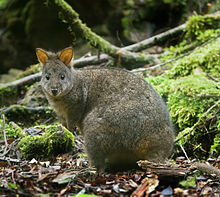Pademelons are small marsupials in the genus Thylogale, found in Australia and Aru, Kai plus New Guinea islands. They are some of the smallest members of the macropod family, which includes the similar-looking but larger kangaroos and wallabies. Pademelons are distinguished by their small size and their short, thick, and sparsely-haired tails. Like other marsupials, they carry their young in a pouch.
| Pademelon[1] | |
|---|---|

| |
| Tasmanian pademelon, Thylogale billardierii | |
| Scientific classification | |
| Domain: | Eukaryota |
| Kingdom: | Animalia |
| Phylum: | Chordata |
| Class: | Mammalia |
| Infraclass: | Marsupialia |
| Order: | Diprotodontia |
| Family: | Macropodidae |
| Subfamily: | Macropodinae |
| Genus: | Thylogale J. E. Gray, 1837 |
| Type species | |
| Halmaturus (Thylogale) eugenii | |
| Species | |
|
7, see text | |
Etymology
editThe word "pademelon" comes from the word badimaliyan in Dharug, an Australian Aboriginal language spoken near what is now Port Jackson, New South Wales.[2] The scientific name Thylogale uses the Greek words for "pouch" and "weasel."[3]
Description
editAlong with the rock-wallabies and the hare-wallabies, the pademelons are among the smallest members of the macropod family. Mature male pademelons are larger than females, with an average weight of about 7 kg and height of 60 cm. Mature females weigh around 3.8 kg.[4]
Species
editThere are seven recognised species within genus Thylogale:[5]
| Image | Scientific name | Distribution |
|---|---|---|
| Tasmanian pademelon or red-bellied pademelon, Thylogale billardierii | ||
| Brown's pademelon, Thylogale browni | ||
| Dusky pademelon, Thylogale brunii | ||
| Calaby's pademelon, Thylogale calabyi | ||
| Mountain pademelon, Thylogale lanatus | ||
| Red-legged pademelon, Thylogale stigmatica | ||
| Red-necked pademelon, Thylogale thetis |
Distribution and habitat
editThe red-legged pademelon can be found in the coastal regions of Queensland and New South Wales, and in south-central New Guinea. In some areas, its range has been drastically reduced.
The red-bellied or Tasmanian pademelon is abundant in Tasmania, although it was once found throughout the southeastern parts of mainland Australia.[6]
The dusky pademelon lives in New Guinea and surrounding islands. It was previously called the Aru Islands wallaby. Before that, it was called the "philander" ("friend of man"), which is the name it bears in the second volume of Cornelis de Bruijn's Travels, originally published in 1711. The Latin name of this species is called after De Bruijn.[7][8]
The natural habitat of the pademelon is in thick scrubland or dense forested undergrowth. It also makes tunnels through long grasses and bushes in swampy country.[citation needed]
Threats
editPademelon meat used to be considered valuable and was eaten by settlers and indigenous Australians.[9][10]
Aside from being killed for their meat and soft fur, their numbers have been reduced by the introduction of non-native predators such as cats in Australia, dogs, and red foxes. The rapid increase in Australia's rabbit population has also caused problems as rabbits graze on the same grasses, making less available for the pademelons. Clearing of land for urbanisation has pushed the larger wallabies and kangaroos onto land that previously was occupied by pademelons with little competition.[11]
Tasmanian pademelons were an important part of the diet of the now-extinct thylacine, and they are still preyed on by quolls, Tasmanian devils, and wedge-tailed eagles. Despite these predators, Tasmania and its outlying smaller islands have large numbers of pademelons and every year many are culled to keep their numbers sustainable.[12]
References
edit- ^ Groves, C. P. (2005). Wilson, D. E.; Reeder, D. M. (eds.). Mammal Species of the World: A Taxonomic and Geographic Reference (3rd ed.). Baltimore: Johns Hopkins University Press. pp. 69–70. ISBN 0-801-88221-4. OCLC 62265494.
- ^ "15 Weird Aussie Animal Names". The Nature Conservancy Australia. Retrieved 27 November 2023.
- ^ Rose, R.W.; Rose, R.K. (2018). "Thylogale billardierii (Diprotodontia: Macropodidae)". Mammalian Species. 50 (965): 100–108. doi:10.1093/mspecies/sey012.
- ^ "Warrawong Wildlife Sanctuary" (PDF).
- ^ "ADW: Thylogale: CLASSIFICATION". Animal Diversity Web.
- ^ Rose, R.W.; McCartney, D.J. (1982). "Reproduction of the Red-Bellied Pademelon, Thylogale billardierii (Marsupialia)" (PDF). Australian Wildlife Research. 9: 27–32. doi:10.1071/wr9820027. Archived from the original (PDF) on 26 April 2012. Retrieved 17 December 2011.
- ^ Lendering, Jona. "Cornelis de Bruijn". Livius.org. Archived from the original on 13 July 2014.
- ^ Chisholm, Hugh, ed. (1911). . Encyclopædia Britannica (11th ed.). Cambridge University Press.
- ^ Driessen, Michael M. (1992). Effects of hunting and rainfall on Bennett's wallaby and Tasmanian pademelon populations (Thesis). University of Tasmania. Retrieved 8 March 2021.
- ^ Milks, Annemieke (2020). "A Review of Ethnographic Use of Wooden Spears and Implications for Pleistocene Hominin Hunting". Open Quaternary. 6 (1). doi:10.5334/oq.85.
- ^ Wiggins, Natasha L.; Williamson, Grant J.; McCallum, Hamish I.; McMahon, Clive R.; Bowman, David M. J. S. (2010). "Shifts in macropod home ranges in response to wildlife management interventions". Wildlife Research. 37 (5): 379. doi:10.1071/wr09144.
- ^ "ABC News". Annual wallaby cull draws criticism. 25 July 2011. Retrieved 7 August 2021.
External links
edit- "Thylogale Gray, 1837". Atlas of Living Australia.